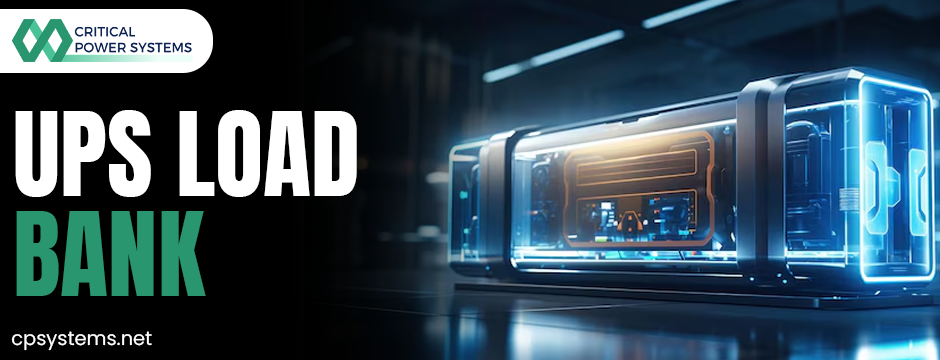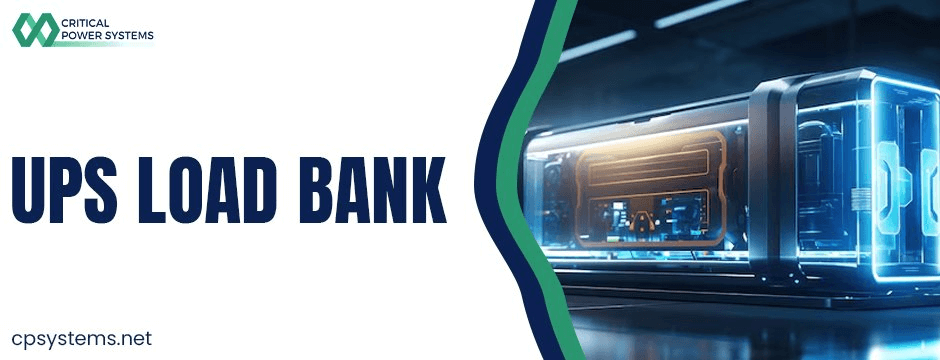In today’s digitally driven world, data centers are the beating hearts of almost every business operation. They store, manage, and deliver critical information in real time—and any disruption, even for a second, can cost millions in revenue, customer trust, and operational efficiency. This is where reliable power infrastructure becomes non-negotiable. At Critical Power Systems, we understand that ensuring 24/7 uptime isn’t just about having a backup power source. It’s about knowing your system will work when it matters most. And that’s precisely the role of UPS Load Banks—they simulate real-world electrical loads to test and verify the actual performance of Uninterruptible Power Supplies (UPS) and backup systems like UPS Battery Cabinets.
Let’s take a deep dive into how load banks serve as the unsung heroes of power reliability in mission-critical environments like data centres—and why they should be a standard part of your power assurance strategy.

Why Power Reliability is Mission-Critical for Data Centres
A power outage of even a few seconds can trigger catastrophic consequences—lost transactions, data corruption, downtime penalties, and customer dissatisfaction. While most facilities are equipped with redundant power sources, like UPS systems and battery banks, many don’t realize that without regular testing under real-world conditions, they’re flying blind.
This is where load banks come into play. They create a controlled, simulated electrical load that allows operators to measure how the entire power ecosystem performs—under stress, and in real time.
What is a UPS Load Bank?
A UPS Load Bank is a device designed to simulate the actual electrical load that a UPS would support during an outage. It draws power from the UPS system, mimicking the demand of real equipment—without affecting production systems.
This simulated demand helps engineers and facility managers evaluate:
- The UPS’s ability to deliver the necessary power
- The condition and capacity of the UPS Battery Cabinet
- Heat dissipation and cooling system response
- Any latent system weaknesses before a real emergency occurs
Think of it like a fire drill, but for your data centre’s power supply.
The True Role of Load Banks in Data Centre Reliability
- Verifying UPS Performance Under Load
The performance of a UPS is only as good as its weakest component. By placing the UPS under an actual load, operators can observe how it behaves—not just in theory, but in practice. This includes response time, voltage regulation, frequency consistency, and more.
- Testing the Health of UPS Battery Cabinets
Your UPS Battery Cabinet is the lifeblood of your emergency power setup. But batteries degrade over time, especially under poor ventilation or high-temperature environments. Load bank testing reveals how much actual runtime your battery cabinets can deliver—and whether they need replacing or recalibrating.
- Validating Generator and Transfer Switch Functionality
Load banks don’t just test UPS units—they’re also used to test diesel generators, automatic transfer switches, and other backup systems. When a real power loss occurs, all these systems must work in harmony. Load bank testing helps confirm that smooth transition.
- Simulating Real-World Power Demands
When done periodically, load bank tests can replicate typical, peak, and even over-capacity scenarios. This gives facility managers an accurate snapshot of how resilient their system is—not just in ideal conditions, but during high-demand events.
Why Load Bank Testing is a Must-Have, Not a Nice-to-Have
Without regular load bank testing, you’re essentially relying on hope—and in the world of mission-critical IT infrastructure, hope isn’t a strategy.
Here’s what’s at stake:
- Reduced risk of downtime during a real power failure
- Early detection of battery deterioration or circuit failures
- Regulatory and insurance compliance
- Extended lifespan of your UPS systems and batteries
- Improved confidence among IT stakeholders, clients, and auditors
When customers ask about your disaster recovery plan, load bank test records are your proof of preparedness.
Sales Perspective: Why Choose Critical Power Systems for Load Bank Solutions?
At Critical Power Systems, we go beyond product supply—we deliver peace of mind. Our UPS Load Banks are built for scalability, mobility, and smart integration. We offer:
- Customizable load bank solutions for small server rooms to hyperscale data centres
- Turnkey testing services, including setup, calibration, monitoring, and reporting
- Integration with modern UPS Battery Cabinets to provide holistic diagnostics
- Trained technicians who understand the criticality of your infrastructure
Our goal? To make sure your backup power systems don’t just exist—but perform under pressure.

Final Thoughts: Don’t Wait for a Power Failure to Discover a Weakness
In the high-stakes world of data centres, every second counts—and every power source needs to perform flawlessly. A UPS isn’t a one-and-done investment; it’s a system that requires validation. Without load bank testing, you’re leaving critical questions unanswered.
By incorporating routine UPS Load Bank testing and verifying the health of your UPS Battery Cabinets, you build an infrastructure you can trust—not just during maintenance windows, but during real-world crises.
At Critical Power Systems, we’re committed to helping businesses create power resilience from the ground up. Whether you’re a data centre manager, an IT director, or a facility planner, now is the time to take action. Let’s test it before you trust it.
Frequently Asked Questions (FAQs)
Q1: How often should UPS Load Bank testing be performed in a data centre?
A: Ideally, UPS load bank testing should be conducted annually, or after any major equipment upgrade or battery replacement.
Q2: Can load bank testing be done without interrupting live operations?
A: Yes. Load banks are typically connected to bypass circuits, allowing testing without impacting live servers or operational workloads.
Q3: What’s the difference between resistive and reactive load banks?
A: Resistive load banks test real power consumption (like heaters or lights), while reactive load banks simulate inductive loads like motors or transformers. Combined testing offers a full system assessment.
Q4: Are UPS Battery Cabinets tested during load bank assessments?
A: Absolutely. Load testing reveals the health, capacity, and remaining life of your UPS batteries under stress conditions.
Q5: Can I rent load banks or do I need to buy them?
A: Critical Power Systems offers both rental and purchase options, depending on your needs and frequency of testing.

